*My understanding is that these sugar snap peas are a hybrid cultivar developed in the U.S. and then introduced to Japan. This is often referred to (or at least used to be) as "Snack" endou スナック豌豆 in Japan. Obviously Japanese misheard "snap" as "snack". Japanese government corrected this and this type of pea is now officially called " Snap" endou or スナップエンドウ.
Sunday, April 24, 2011
Chicken breast with sesame paste dressing 鶏胸肉の胡麻和え
*My understanding is that these sugar snap peas are a hybrid cultivar developed in the U.S. and then introduced to Japan. This is often referred to (or at least used to be) as "Snack" endou スナック豌豆 in Japan. Obviously Japanese misheard "snap" as "snack". Japanese government corrected this and this type of pea is now officially called " Snap" endou or スナップエンドウ.
Friday, April 22, 2011
Sautéed squid with ginger soy sauce イカの生姜焼き
Just after we got married, we rented a house that had a locally-owned grocery store within walking distance. The fishmonger there was Asian and really knew his fish. As a result, we were able to get some remarkably good and interesting fresh seafood. It is really good the store was within walking distance because the refrigerator in the house was from the 1950s and the freezer was only large enough to hold a box of frozen peas. As a result we had to stop almost everyday to buy food for dinner. One day, I came home and there was a bag of fresh squid sitting in the kitchen sink. Apparently, my wife bought fresh uncleaned squid from the fish monger. According to my wife, the cashier asked her, during checkout, if she knew how to clean and prepare squid. She answered with a definitive "NO", but said she assumed, since her husband was Japanese, he would know. Luckily, she assumed correctly. She should have realized, however, that not all Japanese, especially men, know how to clean and prepare squid. I can not remember what I made from the squid that day, just that my wife had such implicit faith (well placed or otherwise) in my culinary skills.
In contrast, where we now live, most squid is of either the previously or "presently" frozen pre-cleaned variety. To my pleasant surprise, however, I found fresh squid (uncleaned) at one of our regular grocery stores. Naturally, I had to get some. Although the freshness was nothing close to those available in Japan (many are still alive), this is much better than frozen ones. Although the exact variety is unknown to me, it was larger than most frozen squid.
I pondered what to make from this squid but decided to make it in a classic Izakaya or street food way; grilled squid with ginger soy sauce. Otsumami yokocho おつまみ横町 page 74 has a similar recipe but this type of squid dish is rather classic. I remember this type of squid (served on a stick, see image on the left) was one of my favorite food stand foods during Japanese festival days* or "en-nichi" 縁日 when I was a kid. (Image from http://wallpaper.free-photograph.net/jp/photobase/yp5821.html).
In contrast, where we now live, most squid is of either the previously or "presently" frozen pre-cleaned variety. To my pleasant surprise, however, I found fresh squid (uncleaned) at one of our regular grocery stores. Naturally, I had to get some. Although the freshness was nothing close to those available in Japan (many are still alive), this is much better than frozen ones. Although the exact variety is unknown to me, it was larger than most frozen squid.
I pondered what to make from this squid but decided to make it in a classic Izakaya or street food way; grilled squid with ginger soy sauce. Otsumami yokocho おつまみ横町 page 74 has a similar recipe but this type of squid dish is rather classic. I remember this type of squid (served on a stick, see image on the left) was one of my favorite food stand foods during Japanese festival days* or "en-nichi" 縁日 when I was a kid. (Image from http://wallpaper.free-photograph.net/jp/photobase/yp5821.html).
*The closest equivalent I can think of in the U.S. would be a county or state fair.

Just in case you have never cleaned squid: You first have to remove the innards by gently pulling the tentacles while holding the body. If you pull it correctly, all the innards come out in one piece. Then remove the cartilage which runs the entire length of the body of the squid. My squid must have had a hard life. The cartilage was broken in the middle in almost all of them. In that case, you have to go back with you finger into the body cavity of the squid and get the remaining cartilage out. As for the tentacles, I cut into them just beneath the eyes and go under the "beak" to cut them from the eyes and innards. If the beak was still attached to the tentacles, make sure you remove it. I then cut the tentacles at the base into two parts. I removed the skin from the body tube, although you do not have to do it. I did not remove the "fin" at the top of the body called "enpera" エンペラ. I scored the tube in an oblique fashion on both sides to make it easier to eat.
I first marinated the prepared squid in a mixture of sake and soy sauce (1:1) and grated ginger root (1/2 tbs) for several hours in the refrigerator. Since I could not have a charcoal fire to grill the squid, I sauteed it instead. After I removed the squid from the marinade, I carefully dried them with paper towels despite this liquid came out from the squid while cooking and prevented it from nicely browning. This was unavoidable since I did not grill on a charcoal fire. After a few minutes turning once I added a small amount of the marinade and reduced the heat for 2-3 minutes and made a sauce to coat the surface of the squid (see below). If I was grilling I would have brushed on the marinade towards the end of the grilling.
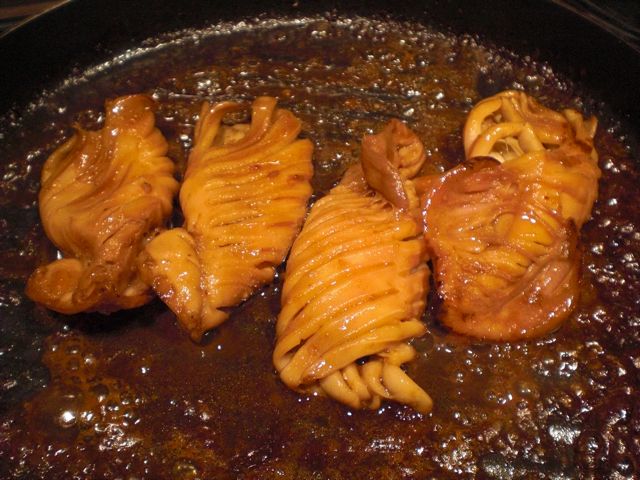
This was not one of my best efforts but the squid was very tender and soy sauce ginger flavor was perfect. For a good measure, I also added a small dab of freshly grated ginger root. We had this with cold sake.
I first marinated the prepared squid in a mixture of sake and soy sauce (1:1) and grated ginger root (1/2 tbs) for several hours in the refrigerator. Since I could not have a charcoal fire to grill the squid, I sauteed it instead. After I removed the squid from the marinade, I carefully dried them with paper towels despite this liquid came out from the squid while cooking and prevented it from nicely browning. This was unavoidable since I did not grill on a charcoal fire. After a few minutes turning once I added a small amount of the marinade and reduced the heat for 2-3 minutes and made a sauce to coat the surface of the squid (see below). If I was grilling I would have brushed on the marinade towards the end of the grilling.
Wednesday, April 20, 2011
Arugula, fennel salad with flat iron steak ルッコラ、フェンネルとフラットアイアンステーキのサラダ
This is another small starter dish I made. This turned out to be very interesting and unique fusion salad.
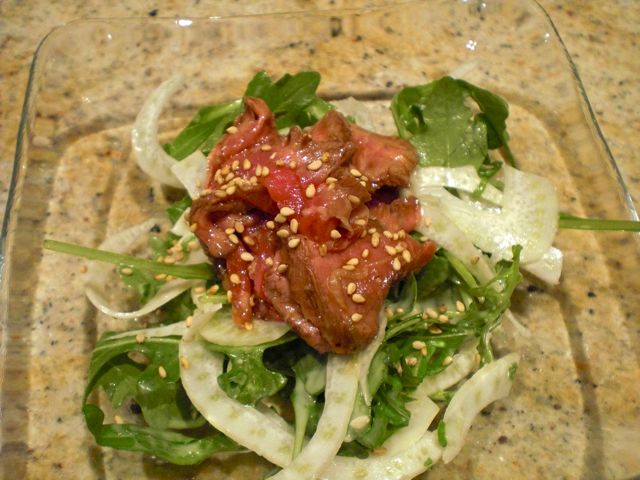
The base is a mixture of baby arugula (it is interesting that this green is often called "rocket" in England, New Zealand, and Australia, "rucola" in Italy, and "rukkora" ルッコラ in Japan but in US and Canada, it is called "arugula") and thinly sliced fennel. Arugula is one of those rare greens that has a nice peppery taste on its own without help from any dressing. Fennel also has very nice anise flavor. As usual, I sliced the fennel with a Japanese mandoline slicer (Benriner) paper thin. For salad, it is important to slice fennel paper thin. I pondered about the dressing but decided to use blue cheese dressing (from the bottle). I used the dressing rather sparingly.
We had this with a very good Cabernet from Sonoma,
Kunde Cabernet Sauvignon Reserve 2005. This is a Bordeaux blend (mostly Cab and some Merlot). It is rather rustic with nice smoky note and big chewy, albeit a bit rough huned, tannin (I know some will hate this type of description but tough). This is not a fruity vanilla laden sissy wine. (Although we sometimes like such sissy wines). For the price, this is a find. We usually think Sonoma Cab is not as good as Napa's but I will take an exception for this wine. This wine has a very high PQR.
I topped this with thinly sliced leftover flat iron steak cooked medium rare. I dressed the steak with a mixture of ponzu shoyu, splash of dark roasted sesame oil and grated garlic. I placed the steak on the bed of arugula and fennel and garnished it with sesame seeds.
The combination of Western flavors of the salad and Eastern flavors of the steak was surprisingly very nice. All these very distinct flavors could be appreciated.
We had this with a very good Cabernet from Sonoma,
Kunde Cabernet Sauvignon Reserve 2005. This is a Bordeaux blend (mostly Cab and some Merlot). It is rather rustic with nice smoky note and big chewy, albeit a bit rough huned, tannin (I know some will hate this type of description but tough). This is not a fruity vanilla laden sissy wine. (Although we sometimes like such sissy wines). For the price, this is a find. We usually think Sonoma Cab is not as good as Napa's but I will take an exception for this wine. This wine has a very high PQR.
Tuesday, April 19, 2011
CityZen for Japan Fundraising event on April 18
We attended CityZen for Japan on April 18 at CityZen located in the Oriental Mandarin Hotel. The location of the hotel is special. It overlooks Washington Harbor and is near the Tidal Basin. We arrived there a bit early so we sat outside on the terrace sipping wine. It was a beautiful spring day, the daffodils were out and it was fun watching the low flying planes approaching National airport over the 14th street bridge. In contrast, we thought of the quake damaged areas of Japan and felt that participating in this event was the least that we could do.
The event appeared to be a great success. Chef Eric Ziebold and Relief International did a great job organizing this. I do not know how many people participated but the restaurant where it took place was quite crowded.
Champagne and wine were free flowing with wonderful Hors d'oeuvre. The auction included offerings from the chefs of participating restaurants. The auction packages included dinner prepared by a renowned chef for you and your friends at your house, one of a kind trip to Napa with dinners and wine tasting (at Dalla valle) etc. I was tempted.
After the auctions, all the wonderful food stations opened up including ones by CityZen and our favorite Japanese restaurants around the city offering delicious food.
This was wonderful evening for a good cause and we were glad we could participate and realized how fortunate we were. Thank you CityZen and friends to organize this event. We wish for a quick recovery of Japanese earthquake and tsunami victims.
Monday, April 18, 2011
Fried Burdock stick 牛蒡の唐揚げ
This is a rather common Izakaya dish, although, for some reason, I have not made it at home until now. There are several different ways to make deep fried gobo. There are gobo chips like potato chip, kakiage tempura, or match sticks like shoe string fries. It can be just deep fried as is, or some kind of batter (tempura batter or buck wheat batter) or flour coating could be used. Another variation infuses some flavors before deep frying.
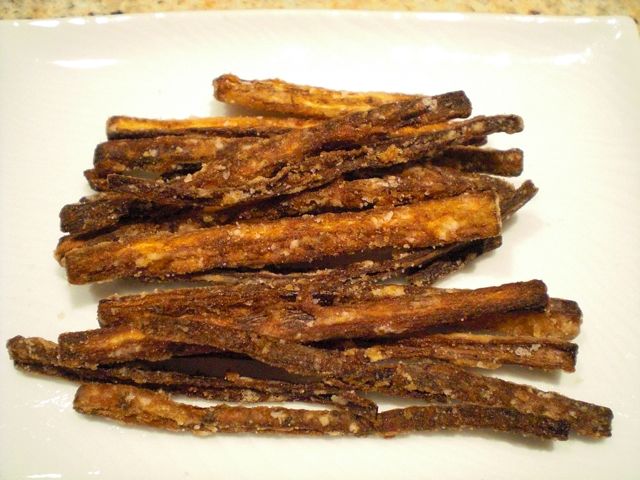
I decided to make shoe string like fries. I also marinated it with sake and soy sauce before frying. I used potato starch to coat the surface to help make it crisper.
My wife was totally sold on this dish. Gobo has a very unique flavor and prepared this was they were so crunchy. It is a bit like sweet potato shoe string fries but gobo is all fibers and crunch. This is probably much healthier than fried potato. This goes well with any drink but we were having cold sake.
For two small servings like those shown above (one serving shown), I used 2 root end halves of gobo. I scraped the skin and cut into match sticks and soaked in acidulated water for 10-15 minutes with several change of water. I then drained and marinated it in a mixture of sake and soy sauce (1:1) in the fridge over night (few hours at room temperature will be fine or you can skip the marinading step all together). I drained the gobo and patted it dry with a paper towel. I then dredged the sticks with potato starch (katakuri-ko 片栗粉).
Instead of deep frying, I shallow fried them using light olive oil (below image) on medium flame. I could have used peanut oil and/or deep fried them. After several minutes, the gobo sticks turned brown and crispy. I drained the excess oil and while they were hot, I seasoned them with salt. Serve while hot.
My wife was totally sold on this dish. Gobo has a very unique flavor and prepared this was they were so crunchy. It is a bit like sweet potato shoe string fries but gobo is all fibers and crunch. This is probably much healthier than fried potato. This goes well with any drink but we were having cold sake.
Saturday, April 16, 2011
Flavored rice with chicken 鶏ご飯
When I posted Chicken rice 鶏飯, I mentioned that if "鶏飯" is pronounced as "tori-meshi" とりめし instead of "keihan" けいはん, it means an all together different dish, which is the dish I am posting here. "Cooked rice" in a polite form in Japanese is "gohan" ご飯, so you could also call this dish, more politely, "Tori-gohan" 鶏ご飯. This is a flavored rice with pieces of chicken. There are many variations and the size and the amount of chicken in this dish also varies. This is my rendition.
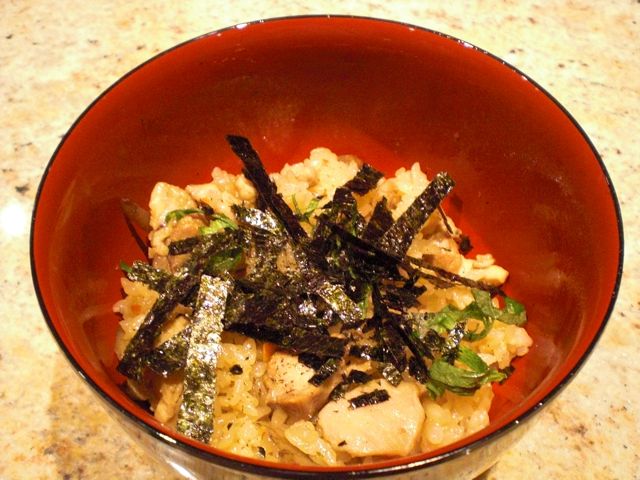
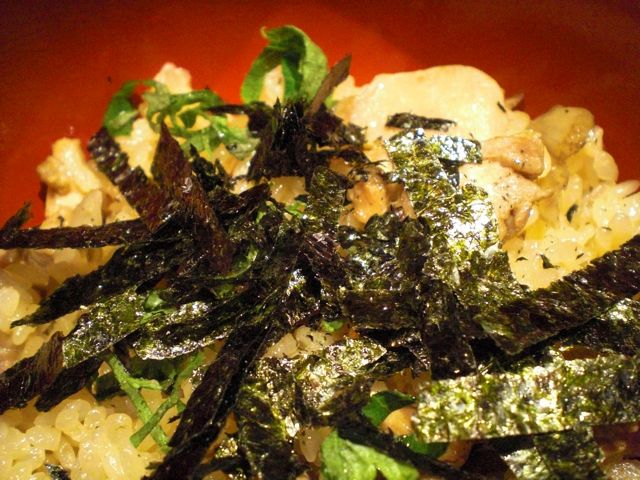
The amount below is for 3 cups (Japanese cup, which is about 180ml, ones come with a Japanese rice cooker) of raw rice which serves 4-6 people (or 10 of us).
Seasoning: I added vegetable oil (1 tbs) in a frying pan on medium heat and first cooked the chicken. When the surface of the chicken became opaque, I added the burdock and carrot and sauteed them for 1-2 minutes. I then added sake (3 tbs), mirin (2 tbs) and soy sauce (2 tbs) and cooked for 1 minute or so. Using a colander or strainer, I separated the solids from the liquid (preserving both separately).
Cooking: This time I used an electric rice cooker but I could have used a Donabe rice cooker. To set up the rice cooker, I added the washed and drained rice and then added the seasoning liquid reserved from cooking the chicken and other ingredients. I then brought the liquid level up to the 3 cup mark by adding dashi broth (or water). I added the chicken and vegetables and stirred it once or twice. I then cooked it like regular rice. After it finished cooking I let it steep for 10-15 minutes (see picture below). With a rice paddle, I stirred the rice and other items (in Japanese culinary parlance, these are called "gu" 具).
Serving: You usually want to add some greens to this dish. Cooked green beans cut into small segments, green pea, snow pea or snap pea can be added as a garnish. In my case, I added a chiffonade of perilla and nori.
Chicken: I used two thighs, bone and skin removed, and cut into small chunks (half inch).
Vegetables: I used ginger root (one thin sliver, skin removed and minced), gobo 牛蒡 or burdock root (1/2), and carrot (1 small). For gobo, after scraping off the dark skin of the gobo using the back of the knife under running water, I cut it into small, thin, "small bamboo leaf shape" which is called "sasagaki" 笹掻き cutting ("sasa" 笹 is a type of small bamboo). This is a very common way to cut root vegetables, especially gobo. You do this by shaving the end of burdock like you are sharpening a pencil (I am not sure how many of you actually shaved and sharpened a lead pencil encapsulated in wood cylinder, i.e. an old fashioned pencil, using a knife). Here is a visual aid for "sasagaki". I put the sasagaki cut burdock in acidulated water (with rice vinegar) immediately. I changed the water several times and let it drain (to reduce the pungent smell/taste and prevent discoloration). I also cut a carrot (one small) in the same way as the gobo. If you like, you could add, a deep fried tofu pouch (abura-age), shiitake mushroom, and/or lotus root (renkon 蓮根); all cut into small pieces.
Vegetables: I used ginger root (one thin sliver, skin removed and minced), gobo 牛蒡 or burdock root (1/2), and carrot (1 small). For gobo, after scraping off the dark skin of the gobo using the back of the knife under running water, I cut it into small, thin, "small bamboo leaf shape" which is called "sasagaki" 笹掻き cutting ("sasa" 笹 is a type of small bamboo). This is a very common way to cut root vegetables, especially gobo. You do this by shaving the end of burdock like you are sharpening a pencil (I am not sure how many of you actually shaved and sharpened a lead pencil encapsulated in wood cylinder, i.e. an old fashioned pencil, using a knife). Here is a visual aid for "sasagaki". I put the sasagaki cut burdock in acidulated water (with rice vinegar) immediately. I changed the water several times and let it drain (to reduce the pungent smell/taste and prevent discoloration). I also cut a carrot (one small) in the same way as the gobo. If you like, you could add, a deep fried tofu pouch (abura-age), shiitake mushroom, and/or lotus root (renkon 蓮根); all cut into small pieces.
Seasoning: I added vegetable oil (1 tbs) in a frying pan on medium heat and first cooked the chicken. When the surface of the chicken became opaque, I added the burdock and carrot and sauteed them for 1-2 minutes. I then added sake (3 tbs), mirin (2 tbs) and soy sauce (2 tbs) and cooked for 1 minute or so. Using a colander or strainer, I separated the solids from the liquid (preserving both separately).
Rice: You could use a just regular Japanese rice but I added sweet rice or glutenous rice. Japanese will call this rice "mochi-gome" 餅米* since rice cakes or mochi 餅 is made from this variety of rice. I used a mixture of regular rice (2 Japanese cups) and sweet rice (1 Japanese cup). This adds a stickier texture to the cooked rice but this is optional. I washed the rice under running cold water until the water ran clear. I then drained and let it sit in the strainer.
*(Digression alert) Mochi-gome contains mostly amylopectin as a type of starch, which gives it a stickier consistency than regular Japanese rice. It can be easily distinguished from a regular Japanese rice since the germ of mochi-gome is opaque. As a result, after washing, the rice grains look white and opaque rather than slightly transparent like regular rice. Some rice dishes, beside rice cake, can be made solely from mochi-gome, which are called "okowa" おこわ. Red rice or "sekihan" 赤飯 served on celebratory occasions in Japan is the example of "okowa".
Cooking: This time I used an electric rice cooker but I could have used a Donabe rice cooker. To set up the rice cooker, I added the washed and drained rice and then added the seasoning liquid reserved from cooking the chicken and other ingredients. I then brought the liquid level up to the 3 cup mark by adding dashi broth (or water). I added the chicken and vegetables and stirred it once or twice. I then cooked it like regular rice. After it finished cooking I let it steep for 10-15 minutes (see picture below). With a rice paddle, I stirred the rice and other items (in Japanese culinary parlance, these are called "gu" 具).
Serving: You usually want to add some greens to this dish. Cooked green beans cut into small segments, green pea, snow pea or snap pea can be added as a garnish. In my case, I added a chiffonade of perilla and nori.
This is a very nice and tasty dish. The addition of sweet rice gave it more body or a "mochi-mochi" もちもち texture, if I am allowed to use a Japanese expression. My wife thought she could not tell the difference from regular rice. This is a perfect "shime" 締め or ending dish or, by itself, with a salad or tsukemono 漬け物 and miso soup, this could be a whole meal.
Thursday, April 14, 2011
Simmered Burdock with aonori 牛蒡の青海苔まぶし
This is a new gobo dish for me. I have not seen, made, or tasted this before. After buying two burdock roots or gobo 牛蒡, I had an excess supply and searched for gobo recipes. I came across this one at e-recipe.com. For more precise recipe, please see e-recipe (in Japanese).
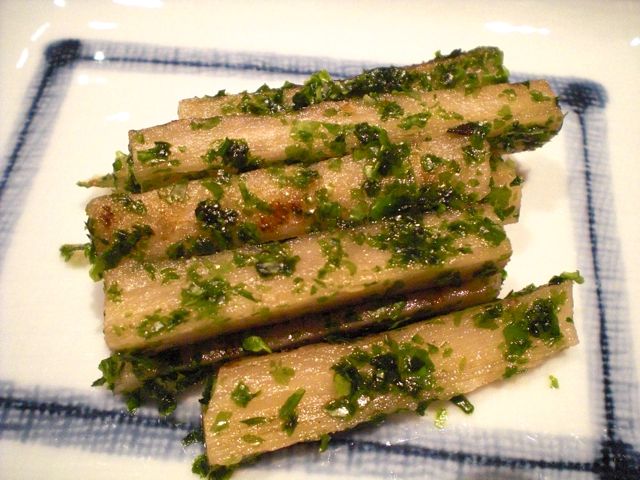
For two servings of the dish seen above, I used the stem end half of the gobo. After the usual scraping of the skin with the back of a knife routine, I cut the gobo into large sticks, half inch or 1 cm diameter and placed them in acidulated water and soaked them for 10-15 minutes with several changes of water.
In a small pot, I added dashi (100ml), sugar (1 tsp) and a small pinch of salt. I reduced the sugar from the original recipe (1 tbs) but even with the reduction it was plenty sweet for me. I placed the gobo in the pot and simmered with a otoshibuta 落し蓋 made of aluminum foil on low flame for 15-20 minutes or until the liquid was almost completely gone. I let it cool down. Just before serving, I added aonori 青海苔(2 tbs or whatever amount you like) to the pot and coated the gobo.
This is a really interesting dish. Beside the flavor of gobo itself, it has sweet and salty taste and the oceanic flavor of aonori. We like other gobo dishes better but this is not bad and certainly different.
Subscribe to:
Posts (Atom)




